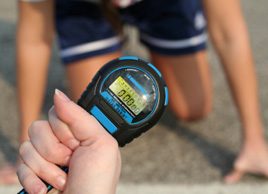Can you get fit quick?
Some exercise plans claim that they can get you fit with less exercise. But can you really get fit quick? Best Health went to the experts to find out

Source: Web exclusive, August 2010
In a hurry? So are we. The good news is that the fitness industry seems to think that they have a solution: high-intensity, short-duration workout programs. But can you really get fit without spending all of your free time at the gym?
Tabata
“Tabata is basically a high-intensity interval training system that was designed by a Japanese speed-skating coach,” says Jane Clapp, head trainer and founder of UrbanFitt, a fitness studio in Toronto. "It involves 20 seconds of full out high-intensity exercise followed by 10 seconds of rest for a total of four minutes."
So what does Tabata involve? Basically anything that will allow you to totally max out by the end of the 20 seconds, says Clapp. (Squats, jumping rope or push-ups are just a few options.)
“You’ve heard that 70 percent of your heart rate is the optimal range to work at and that long cardio is the most efficient way to burn fat." But Clapp challenges this, saying that this method actually isn’t the most efficient way to change your body. "So we’re really moving away from that in the fitness industry. And so, Tabata really marks the general shift away from the low-intensity workouts.“
For people short on time who want to squeeze in a workout , Clapp says to focus on the quality of your workout when your quantity is limited.
“I’d say do something that’s as high-intensity as possible because you’re going to experience the best fitness results by pushing yourself if you only have 10 minutes.“
CrossFit
"The basic concept is this: functional movements constantly varied at a high intensity," says Chris Saini, general manager at CrossFit Vancouver. He describes CrossFit as a mixture of Olympic weightlifting and powerlifting, gymnastics (with the basics of push-ups, pull-ups and squats) and metabolic exercises such as running and swimming.
"There’s a lot of appeal for that shorter workout where you can get…ripped in an hour," says Saini of the program developed in California in the late 1990s.
And according to their website, CrossFit offers clients a different prescription for optimal fitness than the typical sit-ups and lateral raises combined with 20 to 40 minute stints on the treadmill. Instead, they write, they work with compound movements and shorter, high-intensity cardiovascular sessions.
“For every long distance effort our athletes will do five or six at short distance. Why? Because compound or functional movements and high intensity cardio is radically more effective at eliciting nearly any desired fitness result.“
Does it work?
"The short bursts of energy in these types of programs are so brutal, I just don’t think they’re for everyone," says Gina Sherrington, a personal trainer for 360∞ Wellness and Fitness in Nova Scotia. She says that one of her concerns is that the potential for injury is high because form gets lost in the speed of the exercises.
“Exercise is all about variety," she says. "It’s all about changing things around and CrossFit, for example, is a great thing to add in, if you’re a high-level exerciser or an athlete.”
But she says that people have to think about their bodies and ask themselves: is this program enough for me? "Let’s face it: if you’ve got 40 pounds to lose, you’re going to have to do more than 10 minutes a day."




